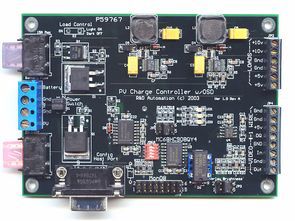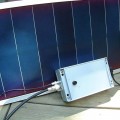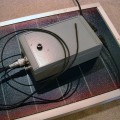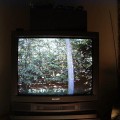
Ever wonder what the birds, deer, or bear were doing in your back “40” when you weren’t around? Just set up the Remote Observation Station, and you can watch the wildlife on your TV in the comfort of your living room! The station includes a camera and transmitter that sends a picture to your TV, which can be up to a mile or two away. The station gets its power from a PV solar panel and a rechargeable battery, which rely upon the system’s control board for direction. The control board also produces battery state information, which it overlays on the picture sent to your TV. So, while you’re watching Bambi, you can also monitor the status of your battery.
The unit integrates six electronic devices including: a CCD video camera, a PV solar panel, a rechargeable battery, a temperature sensor, an RF video transmitter, and the system control board (PVCC). The control board is based on Motorola’s MC68HC908QY4 MCU and sits at the center of the system providing a PV charge controller, two high efficiency voltage regulators, a video sync separator, and an RS232 serial interface for system configuration.
The PVCC control board provides a simple On/Off battery charger using the PV solar panel as a power source. The primary job of the charge controller is to prevent the battery from being overcharged. The control board also adds battery state information in the form of a text overlay (on-screen display, or OSD) to the video signal generated by the CCD camera before it reaches the video transmitter. Additionally, a PC can be connected to the control board via the DB9 connector.
The system has three operating modes: the Configuration Mode, which allows the user to set up its behavior via their PC; the Charge Control Mode with OSD, where the battery’s voltage and temperature are overlaid on to the video signal for feedback to the user; and the Charge Control Mode without OSD, for when the user doesn’t need the diagnostic display. The PVCC Configuration Utility communicates with the PVCC board while in the Configuration Mode. With this utility, the user can set a variety of options, including the full charge set point (the Off set point) and the PV reconnect set point (the On set point). The user can also choose to enable the transmission of an Amateur Radio call-sign if a HAM frequency is being used.

System Overview
The Remote Observation Station integrates six electronic devices including: a CCD video camera, a PV solar panel, a rechargeable battery, a temperature sensor, an RF video transmitter, and the system control board (PVCC). The control board is based on Motorola’s MC68HC908QY4 MCU and sits at the center of the system providing a PV charge controller, two high efficiency power regulators, a video sync separator, and an RS232 serial interface. Figure 1 shows a block diagram of the overall system. Photograph 1 shows the heart of the Remote Observation Station, enclosed in a water-tight aluminum box. Author: Richard Dreher

Source code,circutis etc.:
FILE DOWNLOAD LINK LIST (in TXT format): LINKS-21771.zip
Published: 2012/07/07 Tags: microcontroller projects




4th Floor Elevator Control Circuit PIC16F877
Hello Friends .
In high school I have done an elevator control circuit I want to share with you . I’ve designed a 4-story elevator . What floor is the elevator on each floor, a display showing that , Recall button , and the LED are busy . Likewise in the display in the cabin , which was on the floor , one for each floor indicating LEDs and buttons are available. There are olarakda PIC16F877 microcontroller .